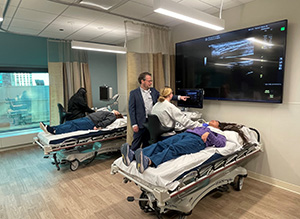NM Invests in Future Sonographers with $1.2 Million Renovation of Ultrasound Lab

At a time when ultrasound exams are being requested at record rates, hospitals across the country have struggled to hire enough sonographers to keep up with the ever-growing demand. According to Edward Carlton, the Program Director for the School of Diagnostic Medical Sonography (DMS) at Northwestern Medicine, this bottleneck is due in part to the difficulties of training future sonographers. Aside from the fact that accredited programs can take up to two years to complete, Carlton explains that “the biggest shortage, as far as the education goes, is getting access to clinical sites.” To address this shortage and better accommodate students, NM has invested in a new, state-of-the-art ultrasound lab for the DMS, which officially opened its doors in January 2025.
The School of Diagnostic Medical Sonography is a 16-month, accredited program run through the NM Academy of clinical schools and programs. Students are admitted as a cohort, typically spending 1-2 days per week in class and another 3-4 days per week in different NM clinics gaining hands-on experience. Prior to the renovation, those classes were held in what Carlton describes as “a 400-square-foot closet with two beds and two ultrasound machines.” The program only accepted six students per cohort back then—still more than the total number of beds and machines, which led to a bottleneck in teaching. However, after the $1.2 million dollar renovation, this 400-square-foot “closet” was transformed into a 1,200-square-foot lab with six beds, allowing them to double their yearly cohort size from six to twelve students.

In addition to the extra space, the renovation also allowed the DMS to upgrade their ultrasound equipment and purchase more phantoms (fake torsos with realistic internal anatomy, similar to ballistic dummies) for students to practice on performing ultrasounds. For a technologically dependent field like sonography, having access to the most cutting-edge machines is essential to preparing future sonographers. “I compare it to a cell phone,” Carlton explains. “If you have a ten-year old phone, sure, it will still work, but it won’t have all the bells and whistles.” The new facility also boasts a 24/7 open lab policy, meaning students can test this equipment whenever they want.
Despite the problems with chronic understaffing, there are many exciting developments in the field of sonography. As Carlton notes, the technological advances to ultrasound equipment have dramatically expanded the possibilities for what can be scanned. Although often associated with fetal imaging, ultrasounds are well-suited for scanning any type of soft tissue, be it kidneys, liver, heart, brain, or even smaller external body parts like fingers or a nose. And given that ultrasounds are less invasive than X-rays, agencies like the FDA are pushing for the use of ultrasound as an alternative imaging tool. With all the advances in ultrasound technology, along with the growing rate of exams requested each year, it has never been more important to train the new generation of sonographers for this rapidly evolving field. By making the investment in the new DMS lab and its students, Northwestern has shown that it is ready to take on that challenge.
The School of Diagnostic Medical Sonography accepts applications from Oct 1 to Feb 15 every year. For those interested in learning more about the program, please follow this link: https://clinicalschools.nm.org/school-of-diagnostic-medical-sonography.html
